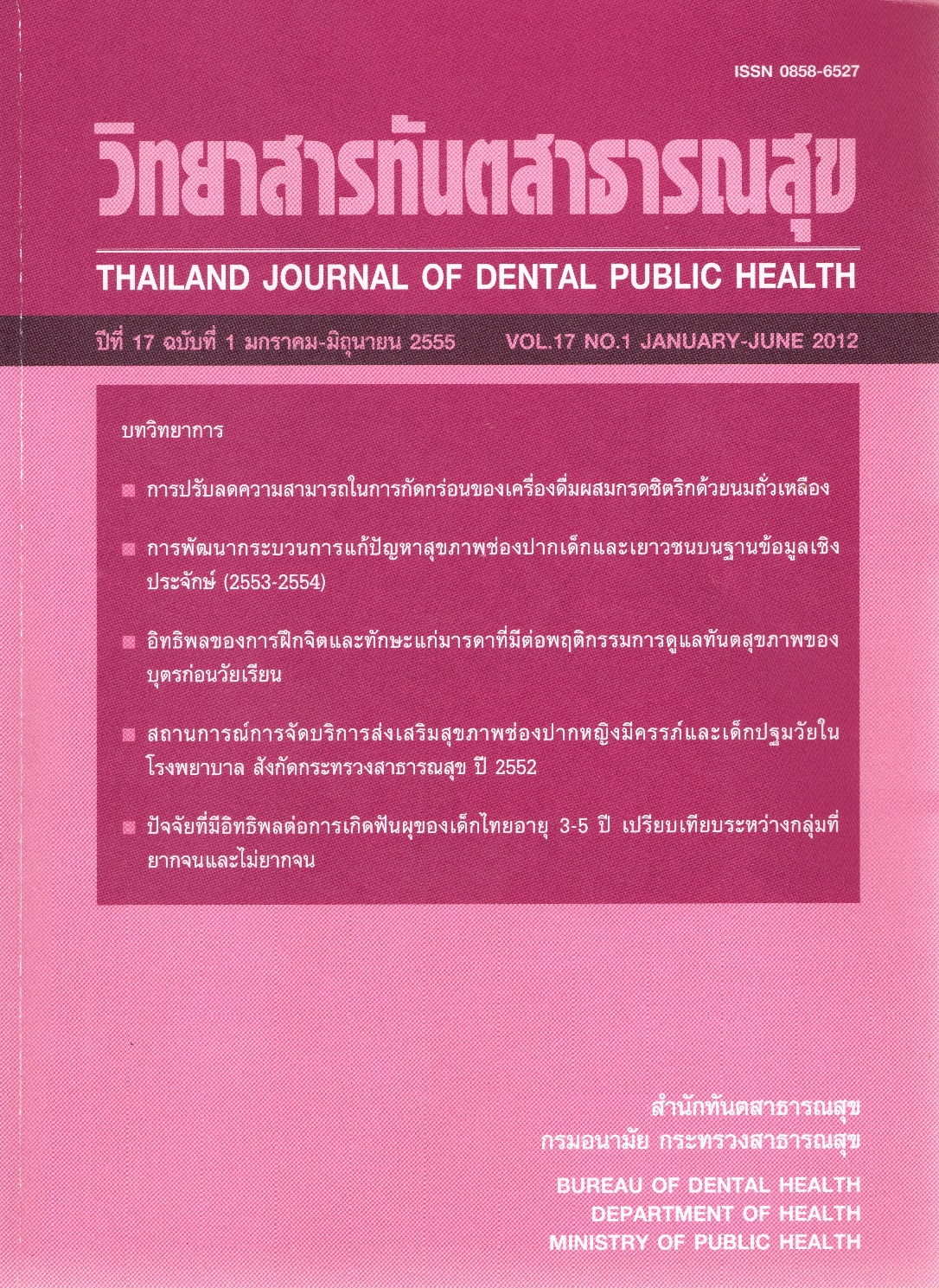Factors related to Dental caries among Thai Children Aged 3- 5 years compare poor and non-poor groups.
Main Article Content
Abstract
The purpose of this study was to investigate the association between risk factors of early childhood caries (ECC) among Thai children aged 3 - 5 years compare poor and non-poor groups. A cross-sectional study was carried out by a sample of 2,113 children with their caregivers from 246 child centers in 20 provinces across the country between Feb-Mar, 2011. Children’s caregivers were interviewed and children‘s oral status were finally examined by the hospital dental personnel. Data analysis was performed with Chi–square test and Logistic regression. Determining the cut of point for low family income per month of 5,000 Baht (29.3 % of the samples), their caries prevalence was found 66.6%, whereas the higher family income was 57.7%. Risk factors, which associated with dental caries, were reported respectively as individual oral hygiene, carbonated beverage’s consumption, the amount of daily intake of snacks and drinks, regular consumption of sugary foods, previous fluoride vanishing, and regular consumption of sweetened milk. Only four associated risk factors showed disparity between the poor and non-poor group, including 1) Poor oral hygiene 2) Previous history of Fluoride vanishing 3) Regular consumption of sugary foods and 4) Average items of snack and drink per dayr. Oral hygiene care is the most strongly associated risk factors to dental caries with disparity economic status. Two factors without disparity economic status were carbonated beverage consumption and regular consumption of sweetened milk.
Downloads
Article Details
References
2. Reisine S, Litt M. Social and psychological theories and their use for dental practice. Int Dent J. 1993; 3: 279-87.
3. กองทันตสาธารณสุข กรมอนามัย. รายงานผลการสำรวจสภาวะทันตสุขภาพแห่งชาติครั้งที่ 6 พ.ศ. 2549-2550. โรงพิมพ์สามเจริญพาณิชย์ (กรุงเทพ) จำกัด, 2551.
4. Ayhan H, Suskan E, Yildrim S. The effect of nursing or rampant caries on height, body weight and head circumference. J Clin Ped Dent 1996; 20: 209-12.
5. Casamassimo PS: Relationships between oral and systemic health. Pediatr Clin North Am 2000;47:1149-1157.
6. Chan SC, Tsai JS, King NM. Feeding and oral hygiene habits of preschool children in Hong Kong and their caregivers' dental knowledge and attitudes. Int J Paediatr Dent 2002; 12: 322-31.
7. Petersen PE. Oral health behavior of 6-yearold Danish children. Acta Odontol Scand 1992; 50: 57-64.
8. Gibson S, Williams S. Dental caries in preschool children: associations with social class, tooth-brushing habit and consumption of sugars and sugar-containing foods. Further analysis of data from the National Diet and Nutrition Survey of children aged 1.5-4.5 years. Caries Res 1999; 33: 101-13.
9. Chen MS. Children’s preventive dental behavior in relation to their mothers’ socioeconomic status, health beliefs and dental behaviors. ASDC J Dent Child 1986; 61: 105-9.
10. Silver DH. A comparison of 3-year-olds’ caries experience in 1973, 1981, and 1989, in a Hertfordshire town, related to family behavior and social class. Br Dent J 1992; 172: 191-7.
11. http://poverty.nesdb.go.th/poverty_new/doc/news/wannee_20071130114433.zip.
12. S. Thitasomakul, S. Piwat, A.Thearmontree, O. Chankanka1, W.Pithpornchaiyakul1, and S. Madyusoh. Risks for Early Childhood Caries Analyzed by Negative Binomial Models, J Dent Res 88(2):137-141, 2009.
13. Vachirarojpisan T, Shinada K, Kawaguchi Y, Laungwechakan P, Somkote T, Detsomboonrat P. Early childhood caries in children aged 6-19 months. Community Dent Oral Epidemiol 2004; 32: 1-10.
14. ชุติมา ไตรรัตน์วรกุล, รพีพรรณ โชคสมบัติชัย. พฤติกรรมการเลี้ยงนมและของเหลวอื่นด้วยขวดนม และปัจจัยที่สัมพันธ์กับอัตราผุ ถอน อุด ในเด็กก่อนวัยเรียนกลุ่มหนึ่ง. ว ทันต 2541; 48:259-68.
15. ทินกร จงกิตตินฤกร. การปฏิบัติตนของแม่ในการดูแลฟันน้ำนมลูกวัย 9-18 เดือน. ว ทันต 2538;45: 253-9.
16. Streckson-Blicks C., Holm AK. Between-meal eating, tooth-brushing frequency and dental caries in 4-year-old children in the north of Sweden. Int J Pediatric Dent. 1995.Jun; 5(2):k67-72.
17. Tsubouchi J, Tsubouchi M, Maynard RJ, Domoto PK., Weinstein P. A study of dental caries and risk factors among Native American infants. ASDC J Dent Child.1995.Jul-Aug; 62(4):283-7.
18. Douglass JM., Tinanoff N., Tang JM., Altman DS. Dental caries patterns and oral health behavior in Arizona infants and toddler. Community Dent Oral Epidermol.2001.Feb; 29:14-22.
19. Harris R., Nicoll AD., Adair PM., Pine CM. Risk factor for dental caries in young children: a systematic review of the literature. Community Health Dent 2004 Mar; 21(Suppl):71-85.
20. สุณี วงศ์คงคาเทพ. ความสัมพันธ์ของการทำความสะอาดช่องปากกับการเกิดฟันผุของเด็กไทยอายุต่ำกว่า 5 ปี. วารสารส่งเสริมสุขภาพและอนามัยส่งแวดล้อม 2551; 31 (2):34-47.
21. จันทนา อึ้งชูศักดิ์, สุภาวดี พรหมมา, สุรางค์ เชษฐพฤนท์, สุพรรณี สุคันวรานิล และ วิไลลักษณ์ บังเกิดสิงห์. พฤติกรรมการแปรงฟันและการเข้าถึงบริการทันตสุขภาพตามชุดสิทธิประโยชน์ของเด็กก่อนวัยเรียน อายุ 6-36 เดือน. ว.ทันต.สธ. 2552;14(1):59
22. สมนึก ชาญด้วยกิจ สุณี วงค์คงคาเทพ ขนิษฐ์ รัตนรังสิมา อังศณา ฤทธิ์อยู่.อิทธิพลของพฤติกรรมการบริโภคอาหารของเด็กไทยอายุ 6 -30 เดือนต่อการเกิดโรคฟันผุ. ว. ทันต 2547: 2: 123-136.
23. บุบผา ไตรโรจน์ จันทนา อึ้งชูศักดิ์ วิไลลักษณ์ บังเกิดสิงห์ และสุรางค์ เชษฐพฤนท์. การศึกษาสถานการณ์การบริโภคนมของเด็กวัยก่อนเรียนในศูนย์เด็กเล็ก พ.ศ. 2546. ว.ทันต.สธ 2546; 8(1-2): 31-37
24. อุไรพร จิตต์แจ้ง ประไพศรี ศิริจักรวาล กิตติ สรณเจริญพงศ์ ปิยะดา ประเสริฐสม และผุสดี จันทร์บาง. รายงานการวิจัยเรื่องการศึกษาพฤติกรรมการบริโภคขนมและอาหารว่างของเด็ก 3-15 ปี พ.ศ.2547. (เอกสารโรเนียว)


